[TABLE TALK] Pad Thai is a dish as patriotic as it is delicious
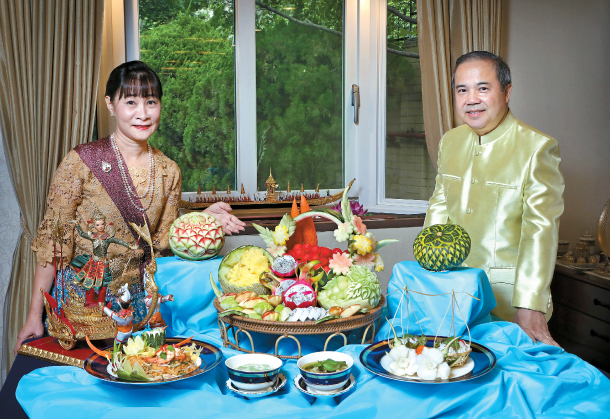
Ambassador of Thailand to Korea, Singtong Lapisatepun, right, and his wife Porndee Lapisatepun, left, present classic signature dishes of Thailand at their diplomatic residence in central Seoul on July 22. From the front left, Pad Thai, Lod Chong (pandanus noodles in coconut milk), green curry and noodles have been decorated with fruits and vegetables carved and presented in a style similar to the practice in the palace for years. [PARK SANG-MOON]
We are asking these questions to ambassadors in Seoul for our latest public diplomacy series, “Table Talk.” The book, its author and what they say about the country is discussed over a table full of national dishes. What better way to start an exploration of a new land than through food, good writing and a personal guide dedicated to building bridges between countries — right here in Korea? - Ed.
We all know the famous dish from Thailand, Pad Thai- noodles stir-fried with prawns and bean sprouts and enjoyed with a pinch of red chili pepper and a squeeze of lime juice. But where did its name came from?
“If you trace the origins of noodle-consuming culture, you know that noodles came from China,” said Singtong Lapisatepun, ambassador of Thailand to Korea, as he and his wife sat with the signature cuisine from his homeland in the dining room of his residence in central Seoul. “Pad Thai, or kwetiau Pad Thai, means ‘noodles stir-fried in the Thai way,’ and the dish came to be called that to remind the Thai people that they are Thai-style noodles.”
Thailand is the only country in the region to not have been colonized by a European power. Its neighbors to the left and right were occupied by either the British or the French.
But it didn’t mean the country was free from outside influences. In fact, there was a time when the Thai government had to remind the people to be proud of their own cuisine and culture.
“The time of the four reigns of the kings of Thailand - from King Rama V to VIII - was one of the most transformative times for Thailand, both domestically and internationally,” said the ambassador. “Those were the years of the two World Wars and when Thailand changed from an absolute monarchy to a constitutional monarchy.”
In the midst of the transformation both within and outside the country, there were efforts in the literary circles to preserve the identity of the Thai people as well.
“Kukrit Pramoj wrote the ‘Four Reigns’ as a gift to the people of Thailand to remind them of their country’s history and culture related to the monarchy,” said Ambassador Lapisatepun. “It was a story to let the people know that Thailand has to adapt to the changes happening around it while keeping its own culture and character intact.”
The novel tells the story of one family living through the years of the four reigns and adapting, and at times resisting, to the changes happening around them. The story sheds light on the inner court life of the king, queen and his consorts, Buddhism and its place in the center of people’s livelihoods and changing Thai society and values.
The following are edited excerpts of the interview with the ambassador and his wife, Porndee Lapisatepun, as they discussed their impressions of the book over signature dishes of Thailand decorated by Mrs. Lapisatepun in the style of the inner court.
Q. How did you come to select the book, “Four Reigns” for the “Table Talk” interview?
A. Singtong Lapisatepun: “Four Reigns” is one of the most popular novels in Thailand. Some records indicate it was one of the top-10 novels at the time of its publication in 1951. The author Kukrit Pramoj was also part of the royal family, and he became the prime minister some 20 years after the book was published.
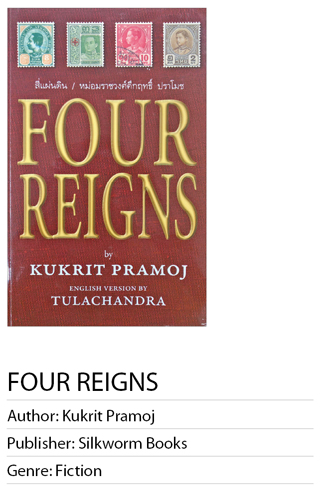
“Four Reigns” by Kukrit Pramoj, the former prime minister of Thailand and grandson of the former king of Thailand, Rama II, tells a fictional story of one family living through the reigns of kings Rama V to Rama VIII, from year 1868 to 1946. The book, originally published as series of stories on newspapers, has since been adapted into soap operas and musicals in Thailand.
Singtong Lapisatepun: It was a very crucial period for Thailand because I think from the time of the reign of King Rama IV, we were influenced by western countries - Myanmar, Malaysia and India were all colonized by the British and on the other side, Laos, Cambodia and Vietnam were colonized by the French. King Rama V reigned for 42 years during the time that Thailand began to accept western influences. We knew that if we didn’t westernize, we would be colonized. And it was the first time that our king traveled to foreign countries like Russia and to Europe.
At the time we also had Thai people traveling outside of the country and learning about the governance systems in Europe. So the kings knew that Thailand eventually had to change. King Rama VI understood this and created a miniature city called Dusit Thani to try democratic practices. King Rama VII wished for a gradual change, but when the revolutionaries demanded more rapid changes, he abdicated to ensure that the country would be kept stable. Thus Thailand became a constitutional monarchy.
The narrator of the story, a former inner court consort named Phloi, shows reluctance to the change from an absolute monarchy to a constitutional monarchy. Would you say that reflects accurately the sentiments of some Thai people at the time?
Singtong Lapisatepun: Remember that this is a novel. But it does shed light on two kinds of people. One would be the conservative, traditional Thai people, who thought that the monarch having absolute power was the best for the country. The other side would be people like Phloi’s son, who studied about democracy abroad, in France and other countries, and began to question the concept of absolute power without checks and balances.
The king is often called the “Lord of Life” throughout the book. Would you say that the people of Thailand hold the same sentiments for the king today?
Singtong Lapisatepun: I think the Thai monarchy has earned the respect of the people. In the past when we had to fight our neighboring countries, it was the king who rode at the front of the battle. And today the king is still the head of the armed forces. So the people know that the king is the leader and someone who can protect the people.
Porndee Lapisatepun: One of the photos of King Rama V hanging on the wall at the residence is actually a cross-stitch work I made 20 years ago, when we were posted to Los Angeles. It took me maybe a month to make it. We take the portrait with us wherever we go because we love our kings and queens, and King Rama V was also an exemplary diplomat. It was during his time that there were reforms and modernizations in governance.
Buddhism is very much part of the people’s lives depicted throughout the novel - in marriages, funerals, festivals and for some royal occasions. Is the religion still a big part of people’s daily lives in Thailand?
Singtong Lapisatepun: Thailand is a Buddhist country and 90 percent of the people are Buddhists. So in our country you can find many Buddhist temples, just like how you can see so many crosses over the rooftops in Seoul. A lot of activities involve Buddhist celebrations - for instance, during weddings, the monks are there to give blessings with water and chants. Ordinary citizens are also granted a chance to take a leave of work during their lifetime to become monks. So Buddhism is part of our everyday life, but we are not closed to other religions. In royal ceremonies we often integrate other religions like Brahminism. But our king has to be a Buddhist.
In a photo taken recently of the prime minister listening to His Holiness the Supreme Patriarch of Thailand, the prime minister appears to be showing much deference to the monk. Would you say religious leaders hold a certain status among leaders in Thailand?
Singtong Lapisatepun: Buddhist monks are highly respected because they made sacrifices in their lives to become monks. They have 227 rules that they have to keep. When you go to any ceremony in Thailand, if there is a monk, everyone has to pay respects to the monk, including the prime minister. And if there is a big Buddhist ceremony in the palace, the king also pays respects to any monks.
Porndee Lapisatepun: When our two sons were ordained to be young monks in their youth, at the celebration of their monkhood, during their monkhood we paid respects to our sons first.
The book also goes into details about the fashion and accessories popular among the inner court women at the time. Is the inner court dress code - for instance, matching colors according to the day of the week - still practiced in Thailand?
Singtong Lapisatepun: It’s not a 100 percent rule, but people believe that if you dress according to the color of the day, then it will be auspicious for you.
Porndee Lapisatepun: Monday is yellow, Tuesday is pink, Wednesday is green, Thursday is orange, Friday is blue, Saturday is purple and Sunday is red. We have a song for kids to sing as well.
What about today’s dishes are particularly Thai in their characteristics?
Singtong Lapisatepun: This is the green curry. Thai people have many kinds of curry - they came from India and South Asia, and we adapted them. We have red, yellow, and green curry. Green curry - we call it kaeng khiao wan - is one of the most popular because it is sweet and mild.
Porndee Lapisatepun: Can you smell the special aroma in the Lod Chong? It is a special aroma found in some Thai dishes. We have a type of candle made from pandanus leaves which we light around the dish and cover for a few hours for the dish to take on the scent.
Some of the fruits and vegetables prepared today are very intricately carved and decorated. Is this style of inner court preparation for food still practiced today?
Porndee Lapisatepun: Some women in Thailand know how to decorate and carve fruits and vegetables in Thailand the way they are presented in the palace. I know a handful of ladies who could have created the same effect here in maybe half the time that I took.
Green curry
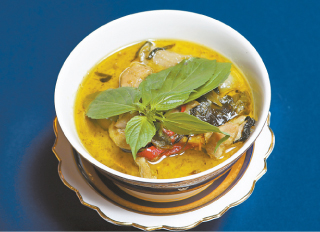
2. Add 50 grams (1.76 ounces) of green curry sauce and stir regularly. Once properly mixed, leave the mixture to settle for a few minutes.
3. Pour the mixture into a heavy base pot and heat the pot over medium heat.
4. In a saucepan, bring to a boil a half cup of chicken soup and set it aside.
5. Add to the pot 200 grams of chicken, one tablespoon of fish sauce, 20 grams of coconut syrup, 150 grams of Thai eggplants, one and a half cup of coconut milk and the boiled chicken soup.
6. Add 10 grams of Thai basil leaves and around two kaffir leaves into the pot and bring the contents to a boil. Once boiled, turn off the heat and serve in a bowl.
Pad Thai
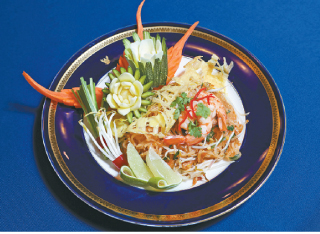
2. Add three tablespoons of vegetable oil to a frying pan and wait until hot. Cook four fresh shrimp in the pan. Set them aside on a plate.
3. In the same pan, add 10 grams of garlic chives, 70 grams of tofu and around 10 grams of chopped preserved turnips. Stir until aroma develops.
4. Put 100 grams of Pad Thai noodles into a bowl of water for a few minutes and drain the noodles. Add the noodles into the pan.
5. Crack one egg into the pan and stir until cooked. Pour the Pad Thai sauce into the pan and mix together.
6. Serve on a plate and add bean sprouts, chopped roasted peanuts, ground chillies and the shrimp.
Lod Chong with coconut milk
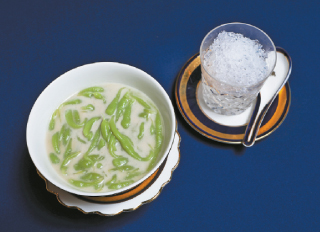
2. Mix one and a half cup of rice flour and a fourth cup of arrowroot starch in a bowl and add the pandanus mixture. Leave for 10 minutes.
3. Pour the pandanus and flour mixture into a pan over low heat. Stir gently and constantly for 40 minutes until the mixture turns into a dough.
4. Put the dough into a noodle press, hold it over a bowl of ice water and press the dough. The noodles should fall into the water.
5. Leave the noodles (Lod Chong) in the water.
6. Mix in a pot 400 grams of coconut milk and 500 grams of coconut palm sugar. Heat until warm and cool it down.
7. Drain the Lod Chong, place in a bowl, add the coconut milk and crushed ice to serve.
BY ESTHER CHUNG [chung.juhee@joongang.co.kr]










with the Korea JoongAng Daily
To write comments, please log in to one of the accounts.
Standards Board Policy (0/250자)